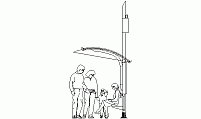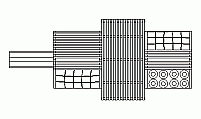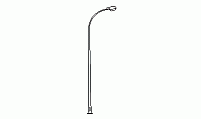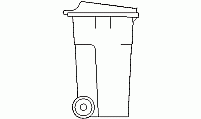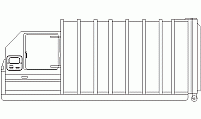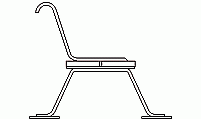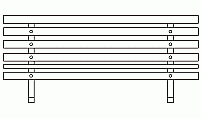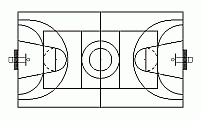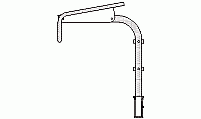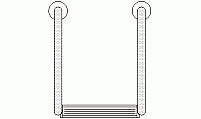CAD Blocks categories
 3D models
3D models home furniture
home furniture sanitary ware - bathrooms
sanitary ware - bathrooms professional equipment
professional equipment doors and windows
doors and windows people and animals
people and animals plants and trees
plants and trees vehicles - transports
vehicles - transports architectural details
architectural details mechanical - electrical
mechanical - electrical urban planning - civil works
urban planning - civil works safety health construction
safety health construction accessible design
accessible design drawing sheet
drawing sheet signals
signals construction machinery
construction machinery accessories and objects
accessories and objects maps and street maps
maps and street maps
Public Litter Bin CAD Block in Top View

size: 5 kb
category: street furniture
related categories:
description: top-down view of a public litter bin with a simple conical design, showing the structural elements of its walls and circular openings.
file extension: .dwg CAD - AutoCAD software
Technical Details and Design Features of the Public Litter Bin
Functional Design of the Public Trash Bin
The public trash bin features a conical design that balances simplicity and functionality. Its circular structure has a wider top opening to facilitate waste disposal and a narrower base for enhanced stability. This design minimizes tipping, making it ideal for high-traffic public spaces like parks, streets, and urban plazas.
The top view of the bin in this CAD block shows evenly distributed vertical panels that form its walls. These panels are not only structural but also decorative, giving the waste bin a clean and modern appearance. This type of trash bin is often used in outdoor environments due to its robust design and practicality. Its compact size and conical shape make it easy to integrate into urban landscapes while maintaining functionality.
Dimensions and Capacity for Public Trash Bins
Public trash bins are designed with ergonomic dimensions to meet the needs of urban waste management. The top opening typically has a diameter of 20 inches (50.8 cm) to 24 inches (61 cm), providing ample space for waste disposal. The base diameter is smaller, ranging from 12 inches (30.5 cm) to 16 inches (40.6 cm), ensuring stability without occupying excessive ground space.
The height of these waste bins is usually between 30 inches (76.2 cm) and 36 inches (91.4 cm), making them accessible for all users. With a capacity of 20 gallons (75.7 liters) to 30 gallons (113.6 liters), these bins are well-suited for managing public waste in high-traffic areas such as parks, streets, and outdoor events. Their dimensions align with international standards for outdoor trash receptacles.
Materials and Installation for Urban Waste Bins
- What materials are commonly used?
- Outdoor waste bins are typically made of durable materials like stainless steel, galvanized steel, and high-density polyethylene (HDPE). These materials resist corrosion, weather conditions, and vandalism, making them ideal for public spaces.
- How are trash bins installed?
- Public trash cans are mounted on concrete bases or anchored to the ground using secure bolts. This prevents tipping and ensures the bin remains in place, even in high-wind areas or crowded environments.
- Are trash bins customizable?
- Yes, public trash bins can be customized with logos, colors, and additional features like recycling compartments. Customization helps align the bin with urban aesthetics or municipal branding.
- How is maintenance performed?
- Regular waste removal, surface cleaning, and inspections are essential to maintain hygiene and functionality. Materials like HDPE and stainless steel require minimal upkeep, making them cost-effective in the long run.
- Do these bins support recycling?
- Many public bins include integrated compartments for recyclable materials, promoting sustainable waste management practices in urban areas.
Benefits of Circular Trash Bin Designs
Circular trash bins are an excellent choice for public waste management due to their compact and practical design. The conical shape ensures stability by lowering the center of gravity, preventing the bin from tipping over in crowded or windy environments. Their wide top openings make waste disposal easy and efficient for users of all ages.
Compared to rectangular or cylindrical designs, circular trash bins provide better spatial integration, making them suitable for parks, sidewalks, and plazas. Their durable materials and ergonomic design minimize maintenance needs, while their aesthetic appeal enhances the overall appearance of public spaces. These features make them a preferred option for urban planners and architects.
Evolution of Public Trash Bins
Public trash bins have evolved significantly over time to meet the growing demands of waste management. Early designs were basic wooden or metal containers, often lacking the durability or capacity required for urban environments. By the mid-20th century, metal bins became standard, offering improved durability and resistance to environmental factors.
Modern public trash cans incorporate advanced materials such as stainless steel and HDPE, along with features like recycling compartments and anti-vandalism coatings. Today, they are designed not only for functionality but also for aesthetics, reflecting the cultural and environmental priorities of urban spaces. These advancements make trash bins an integral part of sustainable city planning.



